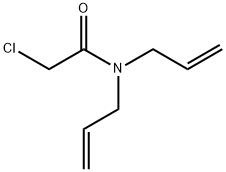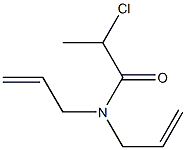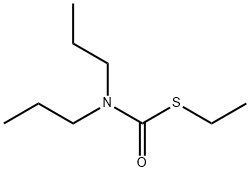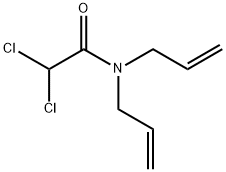ALLIDOCHLOR
- CAS NO.:93-71-0
- Empirical Formula: C8H12ClNO
- Molecular Weight: 173.64
- MDL number: MFCD00034186
- EINECS: 202-270-7
- SAFETY DATA SHEET (SDS)
- Update Date: 2024-12-18 13:37:16

What is ALLIDOCHLOR?
Chemical properties
Amber liquid or granules.Slightly soluble in water; soluble in alcohol, hexane, and xylene.
Chemical properties
An oily, amber liquid. Slightly irritating odor
The Uses of ALLIDOCHLOR
Pre-emergent herbicide.
The Uses of ALLIDOCHLOR
Selective preemergence herbicide used to control annual grass weeds and some broad-leaved weeds in maize, millet, soybeans, sorghum, sugarcane, vegetables and ornamentals.
Definition
An amide that modi- fies RNA and protein biosynthesis and inhibits cell division in primary meristems.
General Description
Amber liquid.
Air & Water Reactions
Slightly water soluble.
Reactivity Profile
Corrosive to steel. .
Hazard
Toxic by ingestion. Dry formulations are irritating to eyes and skin.
Fire Hazard
Flash point data for ALLIDOCHLOR are not available. ALLIDOCHLOR is probably not flammable.
Safety Profile
Poison by skin contact. Moderately toxic by ingestion. An herbicide. When heated to decomposition it emits very toxic fumes of Cland NOx. See also ALLYL COMPOUNDS.
Potential Exposure
Acetamide, and organochlorine herbicide, primarily used to control weeds growing in onion crops. Used as a preemergence and postemergence control for most annual grasses and broadleaf weeds on corn, sorghum, lima beans, snap beans, soybeans, cabbage, peas for canning, celery, onions and some fruits and ornamentals. There are no products registered with the United States Environmental Protection Agency revoked all tolerances on July 21, 1999. There are 25 manufacturers worldwide with 6 located in the U.S.
Environmental Fate
Plant. Allidochlor is translocated in plants to chloroacetic acid and diallylamine. The
diallylamine is further transformed to carbon dioxide. The acid undergoes further degradation to glycollic acid which breaks down to glyoxalic acid. Glyoxalic acid undergoes
further degradation to give formic acid, glycine and carbon dioxide (Cremlyn, 1991)
Chemical/Physical. Emits very toxic fumes of phosphorus oxides and chlorine when
heated to decomposition (Sax and Lewis, 1987).
Shipping
UN2996 Organochlorine pesticides, liquid, toxic, Hazard Class: 6.1; Labels: 6.1-Poisonous materials. UN2902 Pesticide, liquid, toxic, n.o.s., Hazard Class: 6.1; Labels: 6.1-Poisonous materials, Technical Name Required
Incompatibilities
Oxidizers (chlorates, nitrates, peroxides, permanganates, perchlorates, chlorine, bromine, fluorine, etc.); strong acids. Slowly hydrolyzes in water, releasing ammonia and forming acetate salts. Compounds of the carboxyl group react with all bases, both inorganic and organic (i.e., amines) releasing substantial heat, water and a salt that may be harmful. Incompatible with arsenic compounds (releases hydrogen cyanide gas), diazo compounds, dithiocarbamates, isocyanates, mercaptans, nitrides, and sulfides (releasing heat, toxic, and possibly flammable gases), thiosulfates and dithionites (releasing hydrogen sulfate and oxides of sulfur).
Waste Disposal
Organochlorines may be completely dechlorinated by sodium in isopropyl alcohol. The UN Recommends incineration methods for disposal of organochlorines. In accordance with 40CFR165, follow recommendations for the disposal of pesticides and pesticide containers. Must be disposed properly by following package label directions or by contacting your local or federal environmental control agency, or by contacting your regional EPA office.
Properties of ALLIDOCHLOR
| Melting point: | 145℃ |
| Boiling point: | 242℃ |
| Density | 1.042 |
| refractive index | nD25 1.4932 |
| Flash point: | 100 °C |
| storage temp. | 0-6°C |
| pka | -1.13±0.70(Predicted) |
| Water Solubility | 19.32g/L(25 ºC) |
| Merck | 13,258 |
| CAS DataBase Reference | 93-71-0 |
| EPA Substance Registry System | Allidochlor (93-71-0) |
Safety information for ALLIDOCHLOR
| Signal word | Warning |
| Pictogram(s) |
 Exclamation Mark Irritant GHS07  Environment GHS09 |
| GHS Hazard Statements |
H302:Acute toxicity,oral H312:Acute toxicity,dermal H315:Skin corrosion/irritation H319:Serious eye damage/eye irritation H411:Hazardous to the aquatic environment, long-term hazard |
| Precautionary Statement Codes |
P273:Avoid release to the environment. P280:Wear protective gloves/protective clothing/eye protection/face protection. P305+P351+P338:IF IN EYES: Rinse cautiously with water for several minutes. Remove contact lenses, if present and easy to do. Continuerinsing. |
Computed Descriptors for ALLIDOCHLOR
New Products
Tert-butyl bis(2-chloroethyl)carbamate 4-Methylphenylacetic acid N-Boc-D-alaninol N-BOC-D/L-ALANINOL N-octanoyl benzotriazole 3-Morpholino-1-(4-nitrophenyl)-5,6-dihydropyridin- 2(1H)-one Furan-2,5-Dicarboxylic Acid DIETHYL AMINOMALONATE HYDROCHLORIDE 1,1’-CARBONYLDIIMIDAZOLE R-2-BENZYLOXY PROPIONIC ACID 1,1’-CARBONYLDI (1,2-4 TRIAZOLE) N-METHYL INDAZOLE-3-CARBOXYLIC ACID (2-Hydroxyphenyl)acetonitrile 4-Bromopyrazole 5-BROMO-2CYANO PYRIDINE 5,6-Dimethoxyindanone 5-broMo-2-chloro-N-cyclopentylpyriMidin-4-aMine 2-(Cyanocyclohexyl)acetic acid 4-methoxy-3,5-dinitropyridine 1-(4-(aminomethyl)benzyl)urea hydrochloride 2-aminopropyl benzoate hydrochloride diethyl 2-(2-((tertbutoxycarbonyl)amino) ethyl)malonate tert-butyl 4- (ureidomethyl)benzylcarbamate Ethyl-2-chloro((4-methoxyphenyl)hydrazono)acetateRelated products of tetrahydrofuran






You may like
-
 2033-24-1 98%View Details
2033-24-1 98%View Details
2033-24-1 -
 1975-50-4 98%View Details
1975-50-4 98%View Details
1975-50-4 -
 2-HYDROXY BENZYL ALCOHOL 98%View Details
2-HYDROXY BENZYL ALCOHOL 98%View Details
90-01-7 -
 2-Chloro-1,3-Bis(Dimethylamino)Trimethinium Hexafluorophosphate 221615-75-4 98%View Details
2-Chloro-1,3-Bis(Dimethylamino)Trimethinium Hexafluorophosphate 221615-75-4 98%View Details
221615-75-4 -
 61397-56-6 CIS BROMO BENZOATE 98%View Details
61397-56-6 CIS BROMO BENZOATE 98%View Details
61397-56-6 -
 14714-50-2 (2-Hydroxyphenyl)acetonitrile 98+View Details
14714-50-2 (2-Hydroxyphenyl)acetonitrile 98+View Details
14714-50-2 -
 118753-70-1 98+View Details
118753-70-1 98+View Details
118753-70-1 -
 733039-20-8 5-broMo-2-chloro-N-cyclopentylpyriMidin-4-aMine 98+View Details
733039-20-8 5-broMo-2-chloro-N-cyclopentylpyriMidin-4-aMine 98+View Details
733039-20-8